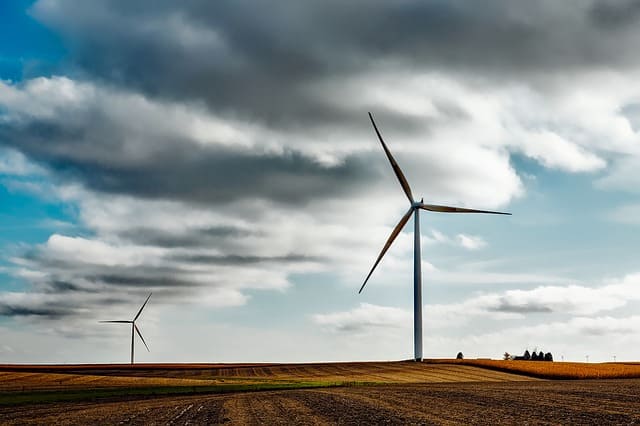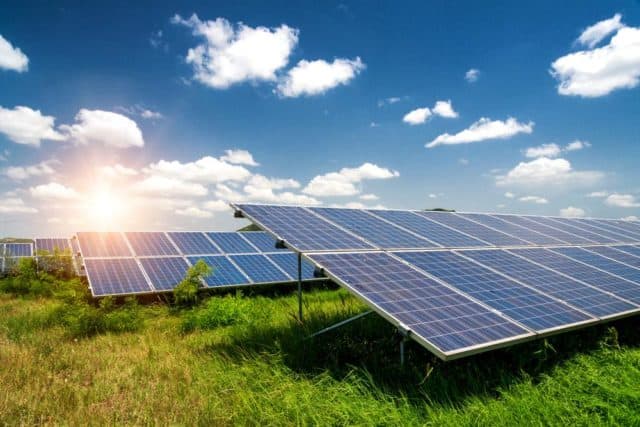Renewable energy, also called alternative energy, refers to the power that is harnessed from natural resources or processes that are naturally replenished. In other words, they are resources that are naturally occurring with examples such as sunlight, wind, tides, waves, and geothermal heat. Further, renewable energy can be classified as follows: solar energy, wind energy, hydroelectric energy, and biomass ( biofuel).
They are increasingly preferred due to their extensive merits including low environmental pollution, creation of employment opportunities, affordability, renewability, and efficiency. The use of renewable energy, in particular, was due to the need to reduce the dependency on fossil fuels, which for a long time since the beginning of the 21 st century used to power industries and for domestic use but with significant environmental impacts including environmental degradation and pollution, and global warming.
When fossil fuels are burnt, they emit toxic gasses including carbon dioxide leading to air pollution and global warming. Spillage and leaking of oil pipes during transportation also results in air and soil pollution, degrading the state of human health as well as the environment. In order to save our fragile planet, therefore, the need for alternative and more reliable energy sources have been on the rise. Here, this article explores more than 25 facts about renewable energy that sheds light on the possibilities and even the history of renewables.
25+ Interesting Renewable Energy Facts
Fact 1. Solar energy, when properly harnessed could meet earth’s energy demand for a whole year-round. There are various ways to harness the sun’s energy, among them, is using solar-powered (PV) panels. Enough sunlight falls on the surface of the earth every hour to meet the earth’s demand for a year. When the sun’s rays hit these panels, through photo radiation, electrons in silicon cells turn the rays into electricity, thus powering our homes as well as our businesses.
Fact 2. 50% of the energy used in the United States of America is sourced from biomass. Wood and it’s bi-products such as paper are a primary renewable resource. In South Iowa, a plant known switchgrass provides energy for the production of electricity. Landfills and dairy farms are also sources of biomass being used to make electricity in other parts of the states.
Fact 3. Geothermal energy was used in mid-1860. Hotels in the state of Oregon used geothermal energy from underground hot springs to heat water in rooms and the rest of the hotel’s facilities. The first geothermal plant was opened in California in the year 1921 that gave rise to numerous research and development studies in universities, which paved the way to the very first geothermal heating equipment to be made in 1948.
Fact 4. China is the world leader in wind power generation. Statistics show that in every hour, two wind turbines are built (since 2017). More than 92000 turbines have been built in China, capable of generating 145 gigawatts of electricity. Wind farms in the United States only generate half of this capacity. China is currently on track to initiate a primary project, to build the world’s largest offshore wind power plant.
Fact 5. The multinational conglomerate company Siemens, 30 years ago built the first-ever commercial offshore wind turbine. Its blades were 5 meters long, producing just 30 kilowatts of power. The latest model has 75 meters blades, producing 6 megawatts (25,000 times as much) – enough to power 6,000 homes.
Fact 6. Solar Impulse 2 was the first plane powered by renewable energy sources. The solar-powered plane completed its world tour landing in Abu Dhabi in March 2015.A first in the history of aviation. Similar attempts were made in 1990 when a solar-powered airplane flew across the United States in stages, using no fuel at all.
Fact 7. The largest wind turbine in the world, located in Hawaii, stands 20 stories tall and has blades the length of a football pitch. Wind power in Hawaii has the potential to provide all of the electricity generation in the sector. Come 2045, the State of Hawaii, USA has plans to be 100% dependent on renewable energy for all electricity consumption.
Fact 8. The major renewables include: Wind, Solar, Water ( hydropower), Biofuel and Geothermal ( energy derived from heat generated under the earth’s surface) and these sources are all continually replenished. Renewable energy sources are derived from natural sources and can be easily replenished.
Fact 9. The entire planet could get all the power it needs from renewable resources by 2050, ending our reliance on fossil fuels and other depleting resources – but only if the right political, financial and societal decisions are made, and quickly. This information is based on a report by the WWF.
Fact 10. In 1921 Albert Einstein was awarded the Nobel Prize in Physics for his discovery of the photoelectric effect. French physicist Edmond Becquerel, in 1839, discovered the photovoltaic effect while experimenting with a cell made of metal electrodes in a conducting solution. When it was exposed to light, the cell produced more electricity and this gave birth to the idea of solar panels.
Fact 11. ‘Green internet’, a more eco-friendly approach undertaken by major tech giants today such as Google, Facebook, and Apple; are using renewable energy sources to power the web. Partnering with institutes that steer environment conservation, these companies as well as web-hosting providers, purchase Renewable Energy Credits (REC’s) and partake in other carbon offset programs to reduce the emission of carbon dioxide.
Fact 12. The world’s resource base for geothermal energy is larger than the resource base for coal, oil, gas, and uranium combined. Located nearly 121km north of San Francisco, California; the Geysers Geothermal Complex is considered the biggest geothermal installation in the world. It has 18 power plants with an active production capacity of 900MW and installed capacity of 1,517MW.
Fact 13. The European Union (EU), which produced an estimated 6. 38 percent of its energy from renewable sources in 2005, adopted a goal in 2007 to raise that figure to 20 percent by 2020. By 2016 some 17 percent of the EU’s energy came from renewable sources. The goal also included plans to cut emissions of carbon dioxide by 20 percent and to ensure that 10 percent of all fuel consumption comes from biofuels.
Fact 14. The most commonly used renewable energy resource is Water. It is estimated to have the capability of producing enough power to meet the needs of 28. 3 million people.
Fact 15. The Three Gorges hydroelectric power plant in Yichang, Hubei province, China, is the largest hydropower station in the world. It provides a whopping 22,500MW. It is a traditional hydropower facility sourcing its water resource from the Yangtze River.
Fact 16. Dependent on the wind’s speed, and the size of the turbine, 1 wind turbine can generate enough electricity to power 1,400 homes. A typical onshore wind turbine with a capacity of about 2.5 to 3 MW can produce more than 6 million kWh in a year.
Fact 17. The Romans are said to be the first to use geothermal energy. Dating back to 1904, Italian scientist Piero Ginori Conti successfully used geothermal energy to power a small generator capable of lighting several light bulbs. From earlier uses such as cooking, bathing, and heating floors and walls; this modest beginning was the foundation for much larger experiments. Larderello was the site of the world’s first commercial geothermal power plant in 1913.
Fact 18. Costa Rica successfully generates more than 98. 53% of its electricity using different sources of alternative energy. Setting standards for other countries to follow suit, over the past four years, it has sustained itself by generating energy from its rivers, volcanos as well as wind and solar power. Costa Rica has a plan to completely put an end to carbon dioxide dependence by 2021.
Fact 19. Fist electric-powered vehicle can be dated to the year 1800. Inventors in the Netherlands, Hungary, and the United States as well as a blacksmith from Vermont, began toying with the concept of a battery-powered vehicle and created some of the first small-scale electric cars. Whether it’s a hybrid, plug-in hybrid or all-electric, the demand for electric drive vehicles is climbing as prices drop and consumers look for ways to save money at the pump.
Fact 20. Geo-Thermal Energy is produced by the hot molten core of the Earth. Magma is found a few miles beneath to the Earth’s surface. The heat of the magma is used to produce steam which in result rotates the generator blades inducing electricity in the system.
Fact 21. Renewable sources of energy get fewer subsidies compared to fossil fuels. Despite the harsh effect of fossil fuels to the environment it attains more subsidies compared to renewable sources of energy. Renewables sources get four times fewer subsidies compared to non-renewable sources.
Fact 22. Since alternative sources of energy came to use, green energy has risen in a ratio of 3 to 1 compared to fossil fuels. Its rise in demand is also creating new jobs. According to Clean Technica, “a national study showed that job creation in clean energy outdoes fossil fuels by a margin of 3-to-1. This also benefits the environment by creating awareness.
Fact 23. More than half of renewable energy sources are devoted to producing electricity. In the mid- 1800 fossil fuels were the major sources of electricity. Serving as a baseline for most present inventions, and all inventions to come e.g. with the rise of technology, affordable alternative energy was on-demand and became more dependent due to its renewable trait.
Fact 24. Renewable energy is a much cheaper alternative in some countries, because of their ability to harness sources of energy that are prevalent to their location. Renewable energy has become the most cost-effective way to generate electricity for hundreds of millions of people worldwide who are not on the grid, especially rural and remote areas.
Fact 25. Water wheels were among the earliest forms of generating hydro-power. In the old times, water wheels were used to generate power – an old-fashioned way of making water turbines that are now used in generating hydro-power. The funny thing is that the wheels can still be used and can even be made from simple things within the household.
Fact 26. The reliability of green energy surpasses that of the power grid. It is widely common for the grid to fluctuate, making it not to be a 100% perfect system. Since green energy utilizes a multi-source power generation system, it can hardly be unreliable, especially compared to the power grid standards.







